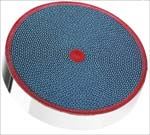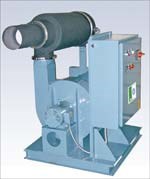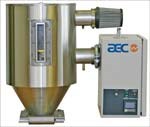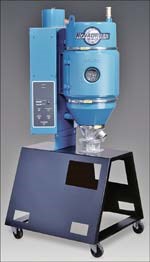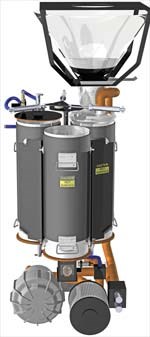Resin Dryers: Which Type Is Right for You?
Processors today face bewildering choices of at least five basic types of dryers, whose capabilities are subject to conflicting claims from equipment suppliers. For the buyer, the most basic questions are: How much drying is needed for the job and which dryer types are up to the task?
Selecting a resin dryer is a more challenging task than it used to be. For many years, the choice was simply between hot-air and dehumidifying desiccant dryers, and that choice was considered relatively simple, based on the materials you needed to dry. But in recent years, new dryer types have appeared on the market or have risen to prominence from their previously small niche presence. As a result, processors now have at least five generically different types of dryers to choose from, and a couple more significant sub-varieties within those classifications.
Hot-air dryers have long been the natural choice for resins that have no affinity to moisture. Non-hygroscopic resins such as polyolefins, polystyrene, and PVC pick up only surface moisture from condensation when exposed to high humidity and changing temperatures. Such surface moisture is easily removed by a stream of heated ambient air.
Desiccant dryers, which account for at least 80% of those in use, have been the "gold standard" for drying resins that have a tendency to absorb moisture. The natural attraction between hygroscopic resins and water molecules causes them to take up and retain water as soon as they are exposed to humid ambient air. Mild to moderately hygroscopic materials include ABS, acetal, acrylic, polycarbonate, PBT, LCP, and some TPOs, TPEs, and TPUs. The most strongly hygroscopic and difficult-to-dry materials are bottle-grade PET and nylon.
The newer dryer choices, all geared to drying hygroscopic resins, include straight compressed-air dryers, compressed-air units with a moisture-removal membrane, and vacuum dryers. Several dryer makers have added some of these options to their arsenal while others are evaluating their potential (see table below). Though all of the new types are finding a place in the market, no one expects large-scale displacement of desiccant drying any time soon.
Meanwhile, there is also a renewed interest in a variant of desiccant technology—the continuous desiccant rotor or "honeycomb" design. And there are newer dryers using radiant heat that are claimed to have greater drying capacity than standard hot-air units.
Evaluating these newer options is complicated by conflicting claims by the hardware makers about drying efficiency, particularly with tougher resins. Most of the newer types also have size restrictions that could limit their ability to compete with desiccant dryers in high-volume applications such as in PET preform molding or sheet extrusion at up to 5500 to 6000 lb/hr.
Hot-air dryers
Often consisting of no more than a blower, a heater, and a temperature control, hot-air units are the oldest, simplest, and least costly drying technology. They use heated ambient air to pull moisture away from the resin. Prices range from as little as $1000 to $3500 for units that dry up to 100 lb/hr, though one can spend as much as $20,000 for units that dry up to 6000 lb/hr for large extrusion applications.
Because these dryers are at the mercy of inconsistent ambient air humidity, they traditionally have been relegated to removing surface moisture from non-hygroscopic resins and to preheating resin prior to molding. They may also be suitable for drying some mildly hygroscopic resins. Says Pete Stoughton, commercial manager for dryers at Conair, "Depending on the region, hot-air dryers can be used for several months of the year for some mildly hygroscopic materials such as certain TPEs, polyolefins whose additives don't retain moisture, and even ABS for non-critical applications."
Adds Kaihan Tavakoli, ACS Group product manager for materials handling, "People have to ask, how dry does dry have to be for my application? Controlling the final moisture content in the resin is not necessary for many processors of certain hygroscopic materials, including ABS and some nylons. They might be better off with a hot-air dryer rather than a desiccant. Atmospheric conditions are important: How much moisture is in the air that a particular material can suck up?"
Two suppliers, Cactus and Canam, make a special variety of hot-air dryer for small to medium-sized molding machines. They use either heater bands or heat pipes to distribute heat rapidly and evenly (±1° F) from top to bottom. They differ from other hot-air types in that they use radiant heat in the hopper rather than a forced stream of externally heated air to heat the pellets. According to Canam's president, Jim Nielson, this type can dry hygroscopic resins: "Heating the pellets increases the vapor pressure in the pellet and forces entrapped moisture to the pellet surface." He even claims these dryers can dry bottle-grade PET to the required moisture levels of 50 ppm (0.005%), though competitors are skeptical.
Canam's Speedryer uses heat pipes inside the hopper and a vacuum motor to draw moist air out of the top of the unit. Two models have throughput capabilities of 25 to 35 lb/hr and 40 to 50 lb/hr. The company sees big demand for very small units and will introduce a model for 5 to 15 lb/hr in 2006.
According to Nielson, these dryers generally use only about 25% as much total energy as desiccant dryers. Also, residence time with these dryers is much less than for many other types of dryers due to the very fast transfer of heat into the pellets. "We can dry nylon in about 20 to 30 min versus maybe 4 to 6 hr for a desiccant dryer," he says.
Cactus' Superdryer uses heater bands around the outside of the hopper and a compressed-air venturi to draw moist air out the top. The smallest model dries 3 to 15 lb/hr and the largest 80 to 250 lb/hr, depending on the resin type. Their drying capacity for resins such as PET and polyurethane is on the low end of the range; ABS, acrylic, nylon, PBT, PC, PVC, and SAN are in the middle; and PE, PS, and acetal at the high end.
Desiccant dryers
Desiccant dryers come in three basic styles: twin-tower and carousel designs with two or more desiccant beds, or models with rotating "honeycomb" wheel desiccants. Desiccant dryers can achieve -40 F dewpoint, considered adequate for drying any hygroscopic resin. Drying residence time is typically 1 to 4 hr, depending on the resin.
Desiccant models are more expensive than hot-air types. A unit that can dry 20 to 25 lb/hr sells for around $2500; one for 100 lb/hr costs around $5000 to $6000; and large units for 5500 to 6000 lb/hr run about $90,000.
In recent years, desiccant dryers have advanced significantly in compactness, drying controls, and energy savings. State-of-the art features include closed-loop cooling after regeneration, which keeps atmospheric moisture away from the freshly regenerated desiccant bed, avoiding dewpoint spikes during bed changeover. Also, dewpoint monitoring with regeneration on demand reportedly cuts energy use by up to 25% to 30%. Another way recent models save energy and prevent overdrying is by adjusting airflow and heating automatically based on sensing the temperature differential between incoming and outgoing air, notes Steve Parker, auxiliaries division manager at Wittmann.
Charles Sears, president of Dri-Air Industries, also notes that some newer designs are easier to maintain than others. "With some designs, desiccant beds may be more difficult to access. Others still have mechanical relays instead of solid-state heater controls."
Says Ed Boochard, technical associate at Eastman Chemical Co.'s Specialty Plastics Div. in Kingsport, Tenn., who is known for his experience in evaluating drying equipment, "I expect desiccant-bed dryers to remain dominant because they are cost-effective and lend themselves to so many processes." He cautions that they are not all created equal, noting that some designs have "Achilles heels," such as a drop in air flow or temperature spikes when switching desiccant beds. "The key to getting the best out of desiccant dryers is good preventive maintenance—cleaning filters, checking seals in hoppers, checking hoses for cracks, making sure the desiccant bed is rotating," he advises.
Desiccant-rotor dryers provide continuous closed-loop drying. Different sections of the rotating desiccant wheel are exposed to process air, regeneration, or cooling. The in-process portion of the wheel is said to absorb moisture at a more constant rate than a standard desiccant bed, eliminating dewpoint and temperature spikes, which were problems with older desiccant-bed designs, though suppliers say they have been minimized or eliminated with newer ones. Desiccant-wheel technology reportedly also requires less maintenance and eliminates contamination problems associated with desiccant beds.
There are now five suppliers of this type of dryer: Matsui America, which introduced this technology to plastics more than a decade ago (and claims 20,000 units now in use), Bry-Air, Comet Automation, Conair, and Wittmann. Both the ACS Group (parent of AEC, Colortronic, and Sterling) and Process Control are considering adding such a dryer to their portfolios.
Comet Automation switched its desiccant dryers entirely to honeycomb rotors in 2001. Says president Tom Rajkovich, "In 10-15 minutes you can go from regeneration to cooling to process again. There are not as many moving valves as with regular desiccant dryers, and the rotor can be washed easily with just distilled water, which you can't do with desiccant cartridges."
These dryers are more compact—e.g., a 40% to 60% smaller footprint for Conair's recently introduced desiccant-rotor (Carousel Plus) series. The rotor design also uses about 5% less energy than conventional desiccant-bed dryers. Drying residence times are also reduced. Says Matsui's sales manager Greg Lewis, "Our desiccant rotors can dry materials in 1 to 2 hr vs. 4 to 6 hr with some desiccant-bed dryers."
Conair's Stoughton agrees that a desiccant rotor is able to provide low-dewpoint air in a shorter time—as little as 10 to 15 min—but he cautions that drying residence time should still follow the resin supplier's guidelines, which generally call for several hours.
Some sources claim desiccant rotors have a downside in maintenance requirements for the main wheel assembly, tension screws on seals, and leaky seals on the rotor. Although suppliers of these units claim a 15-yr life span for their rotors, some dryer manufacturers have shied away from this design. Says Dri-Air's Sears, "Desiccant rotors are expensive to replace—$1500 to $2000—and my understanding is that installation is very labor intensive. For our tower systems we recommend desiccant replacement on a three-year cycle at a cost of $100 to $150 per bed."
Counters Matsui's Lewis, "We guarantee a 15-yr life for our desiccant rotor, and after that time, replacement would cost only $300 to $800. Futhermore, replacing one now takes less than 1 hr." Five years ago, he says, that would have taken 2 to 3 hr.
Conair's Stoughton cautions that the lifetime of any type of desiccant depends on conscientious preventive maintenance to avoid contamination.
Compressed-air dryers
Several suppliers now offer this rather simple drying alternative. Plant compressed air is introduced at the bottom of the dryer and expanded to atmospheric pressure, which immediately drops its dewpoint by 40° to 50° F. The air is then heated to raise its drying capacity further before it passes up through the resin hopper. This type of dryer has no desiccant, no moving parts, no regeneration heater, no valves, no cooling coils. It requires minimal maintenance—just change air filters every six months.
Dewpoint of the drying air depends on the temperature and humidity of the air coming into the plant's air compressor. Many of these dryers can achieve a minimum of about +5 F dewpoint. Most suppliers of these units recommend them for drying certain hygroscopic resins such as ABS, acrylic, acetal, and glass-filled nylon. But for drying materials that require a lower dewpoint—such as PET, PBT, or PC—Motan and Novatec offer an add-on desiccant-bed kit or a moisture-removal membrane (see next section).
The cost of these units can range from $3000 to $4000 for throughputs up to 50 lb/hr and $10,000 to $12,000 for drying 150 to 250 lb/hr—the largest size offered by most manufacturers. Larger units for drying up to 3500 lb/hr in applications such as PET extrusion can run around $70,000 and are offered in North America only by Fasti USA.
Fasti USA, which supplies only compressed-air dryers, is understandably one of the strongest advocates of this technology. President Rainer Farrag says these units provide energy savings of 22% to 60% vs. desiccant designs. His patented design for the larger models minimizes energy consumption by separating resin preheating from moisture removal. A portion of the hot exhaust air is recycled from the top of the hopper and reintroduced via a blower back into the center of the hopper. That air preheats the pellets in the upper part of the hopper to facilitate moisture removal by compressed air entering the bottom of the unit. The heated, decompressed air—only about 25% of the total airflow—is adequate to heat the pellets in the lower half of the hopper.
Some other suppliers think Farrag may be overstating the case when he claims that, "in some applications like blow molding, energy consumption for drying can be reduced to nearly zero. The exhaust air from blow molding (which uses compressed air) is used for drying and the heat can be recovered from the air compressor."
Farrag maintains that his company's dryers can efficiently dry even bottle-grade PET. "Standard-quality compressed air with a dewpoint of 41 F at 100 psi or higher is very sufficient for the job. This equals atmospheric air at -4 F dewpoint at sea level. The key is air flow—if it's high enough, you get much better drying than by using less air with a lower dewpoint. We feel we can achieve more consistent and better results with most hygroscopic resins than with desiccant."
Eastman's Boochard notes that compressed-air dryers are roughly comparable in cost to conventional desiccant dryers, but air compressors are costly to run, and thus compressed-air drying can be cost-effective for some processes but not for others. For example, in a large extrusion blow molding operation, large compressed-air dryers can prove cost-effective by reusing the compressed air from the blowing operation. But an injection molding operation might not have sufficient extra compressed-air capacity available for drying, so that would require additional investment and operating costs. Adds Boochard, "You need to consider what happens if you scale up your manufacturing and need more drying capability and thus more compressed-air capacity, which can get very expensive."
Universal Dynamics' v.p. of engineering Bob Crawford says there is no big difference in energy costs between using compressed air and desiccant drying. In simple terms, the energy used to regenerate desiccant balances the energy used to compress air. "But you need to make sure you have enough compressed air dedicated to that dryer," he cautions. "That's why the smaller units have proved more successful—because they won't change the compressed-air needs of the facility." For example, Motan, which introduced its first compressed-air models in 2003, offers sizes only up to 55 lb/hr.
Compressed air + membrane
These dryers also use heated compressed air but also have special moisture-removal membranes that purge themselves automatically and continuously. These dryers are said to achieve -40 F and lower dewpoints, so they can dry even the most hygroscopic resins. Compressed-air-with-membrane dryers generally cost $4500 to $14,000, with the membrane accounting for $1000 to $2000 of the total.
Tavakoli from ACS Group and others see these units as suited to niche markets such as medical/pharmaceutical components and CD/DVD production. In addition to providing low dewpoint, the membrane can help compensate for limited compressor capacity or poor compressor performance that might otherwise require buying a desiccant dryer or upgrading the compressor. Says Tavakoli, "For conventional applications—say, drying at 200 F with 150 cfm of air at -40 F dewpoint—desiccant dryers are more economical to operate. But if you are drying at 300 or 400 F, compressed air may have an advantage because a desiccant dryer may require an after-cooler, which adds more to energy requirements."
He adds that if you are drying at 200 F or higher, you can achieve 5% to 10% energy savings over desiccant dryers. But at lower temperatures (180 to 200 F), compressed-air dryers use more energy than a desiccant type. Another disadvantage of compressed-air dryers, he says, is limited size of available membranes. "We use three or four membranes in our larger units at a cost of $1000 per membrane."
Says John Gillette, v.p. of Novatec, whose NovaDrier was the first compressed-air/membrane dryer on the market, "In general, I think you can consider this type of dryer for throughputs of 150 lb/hr or lower. You can make them larger, but the compressed air and membrane can get expensive. Above 150 lb/hr, you should probably opt for desiccant technology." The NovaDrier made its debut in 2000 and over 1200 units have been sold.
Conair's Stoughton adds, "While the membrane gets you down to -40 F, the problem is that you achieve this dewpoint only at the bottom of the hopper. Also, the cost of membranes is high and contamination can be an issue." He says Conair is considering the introduction of a compressed-air dryer with a membrane, but it would be limited to under 50 lb/hr to minimize use of costly compressed air.
Dri-Air expects to introduce compressed-air dryers with a membrane by the end of the year. They will be aimed at small throughputs—50 lb/hr or less. Says Sears, "Unless you have a good quality compressor system, you need the membrane. When you simply compress ambient air, you get saturated air. The only way you can remove the moisture is with a refrigeration system or chiller. If you have that to dry your compressed air, you don't need the membrane to remove the moisture."
Vacuum drying is newest
Instead of blowing hot, dry air over the pellets to draw out the moisture, the newest type of dryer on the market uses vacuum to reduce the boiling point of water, literally pulling the water vapor from the resin pellets. Makers of these units boast of using only 20% as much energy and 17% as much drying time as other dryers. They also permit much lower drying temperatures—e.g., 300 F for PET vs. the usual 350 F. Vacuum dryers can reportedly dry most hygroscopic resins.
Maguire Products offers semi-continuous units that carry out heating and vacuum drying in separate stations simultaneously. Matsui USA offers batch units that combine heating and vacuum drying in one station and are designed for micro-molding (15 to 30 lb/hr). Vacuum dryers are priced at $10,000 for the smallest models to $45,000 for 1000 lb/hr.
In 2000, Maguire launched its Low-Pressure Dryers, the first vacuum models for plastics processors in North America. Before then, only resin suppliers had used vacuum—in very large-capacity drying systems. Maguire says it has sold about 900 LPD units in sizes from 30 to 1000 lb/hr. Says Patrick Smith, v.p. of sales, "Our dryers draw a vacuum level of 28 in. of mercury, or 93% of the 30-in. full vacuum in the large dryers used by resin suppliers. Our LPD dryer carries out heating and vacuum drying simultaneously in separate stations, making possible small batches and, in effect, transforming a batch process into a continuous one that keeps pace with the throughput of the plastics processing machine. The small batch size and short drying cycle allow for shorter ‘Monday morning' cold start-ups in less than an hour vs. several hours for a desiccant dryer."
Maguire's three step carousel process involves indexing three canisters. First is the heater canister where the material is preheated with a blower. According to Smith, this typically takes 20 to 35 min less than what is recommended for a desiccant dryer. "We then index the carousel, seal the canister top and bottom, and draw the vacuum. This step takes a maximum of 30 min." In the third position, the dried material is held ready for processing. Polycarbonate can be heated within 20 min and then vacuum dried for another 20 min, for a total of 40 min vs. 4 hr recommended for desiccant drying. "The three-station indexing system also makes possible color and material changes on the fly, eliminating downtime," Smith notes. Because of the lower temperatures used, Maguire recommends vacuum dryers for heat-sensitive wood-filled plastics.
He says overdrying of nylon cannot happen with the LPD dryer. "Because the drying canister is not quite at full vacuum, there is always a bare minimum of moisture left in the system. The moisture levels inside and outside the resin pellets eventually reach equilibrium and that proves to be about 0.12%," he says.
Vacuum drying reportedly uses 70% to 80% less energy than desiccant drying because it eliminates regeneration heating and cooling. Smith also touts lower maintenance, since there are only the filter for blowers and seals for the canisters that need occasional replacement. Made of high-temperature silicone, the seals carry a 5-yr warranty.
Until recently, vacuum dryers were limited to a maximum of 100 to 200 lb/hr. But with the recent introduction of Maguire's 1000-lb/hr model, an LPD can be used as a central dryer for several processing machines, as is the case with other dryers. Smith says this is the first LPD model suitable for large-volume PET processors. Maguire plans to focus more on this market and is now aiming for a 2000-lb/hr model.
Matsui has offered two models of Thermcuum Plus Mini vacuum dryers for a few years. One is sized for 10 lb/hr and the other for 33 lb/hr. Says Greg Lewis, "We don't see vacuum technology as a practical drying option for most custom molders, but rather for niche markets such as micromolding or for materials that have a lot of outgassing (e.g., of plasticizers) that gum up molds. We can reduce these contaminants so that molders can slash mold maintenance by two-thirds."
Matsui's batch vacuum dryer design differs from Maguire's. The rotating LPD assembly allows for larger throughputs, Lewis concedes. Small Thermcuum dryers use special "heat fins" to conduct heat into the pellets in a sealed hopper and then vacuum is applied to the whole hopper. "Material is dried in less than 1 hr. We then keep the material sealed so that it is hot and dry until it is needed by the machine. Then a little valve opens to allow material to come out a little at a time." He notes that this is different from the Maguire system, in which the material is allowed to cool after drying.
ACS Group's Tavakoli says that firm is working on a vacuum dryer and may introduce it in 2006. "We are aiming to improve on the technology by using conductive or radiant heat that would both heat and dry the material better." Echoing some other suppliers' criticisms of current technology, he says vacuum dryers need more uniform heating inside the hopper and better protection of already dried material from exposure to ambient air. Like some other suppliers, he is also skeptical of using vacuum drying for PET: "While these units can do a fine job for many materials that do not require low moisture, for very critical materials such as PET they can be a real problem."
Fasti USA's Farrag, who patented the technology back in the early '90s when he was with Fasti Austria, says vacuum is the best way to dry resins in a batch system, but continuous vacuum dryers with multiple vacuum chambers in a carousel configuration were unsuccessful in the past. "There are too many moving parts with very high maintenance necessary to make the system operate in continuous mode. The chambers are difficult to clean when changing to a different resin or color."
Eastman's Boochard has found vacuum drying to be very effective with polymers that have a high glass-transition temperature (Tg of at least 100 C or 212 F), such as PET, PC or ABS; but he does not see vacuum drying as viable for polymers with Tg of under 160 F, such as PETG.
"We tried Maguire's vacuum dryers with PETG and could not reach the desired pellet moisture content—about 0.02% to 0.03%. This is principally a batch process, and with polymers that require lower drying temperatures you need longer residence time, to which the batch process does not lend itself. If you slow down the canister rotation, the molding process will run out of polymer, so that won't do. As the size limitation is being overcome for these dryers, I can see this as a possible option for PET bottle preforms, but not for PETG sheet extrusion."
|
WHO SUPPLIES WHICH KINDS OF DRYERS
|
|||||
| Supplier |
Hot Air
|
Desiccant
|
Compressed Air
|
Compressed Air with Membrane
|
Vacuum
|
| AEC |
X
|
X
|
X
|
X
|
|
| Bry-Air |
|
X
|
|
|
|
| Cactus |
X
|
|
|
|
|
| Canam |
X
|
|
|
|
|
| Colortronic |
X
|
X
|
X
|
X
|
|
| Comet Automation |
X
|
X
|
X
|
|
|
| Conair |
X
|
X
|
|
|
|
| Dri-Air |
X
|
X
|
|
|
|
| Fasti USA |
|
|
X
|
|
|
| Foremost |
X
|
X
|
X
|
X
|
|
| IMS |
X
|
X
|
•
|
•
|
|
| Labotek |
|
X
|
|
|
|
| L-R Systems |
X
|
X
|
|
|
|
| Maguire |
|
|
|
|
X
|
| Matsui |
X
|
X
|
X
|
X
|
X
|
| Motan |
X
|
X
|
X
|
X
|
|
| Novatec |
X
|
X
|
X
|
X
|
|
| Process Control |
X
|
X
|
|
|
|
| Sterling |
X
|
X
|
X
|
X
|
|
| Thoreson-McCosh |
X
|
X
|
|
|
|
| Universal Dynamics |
X
|
X
|
X
|
|
|
| Walton/Stout |
X
|
X
|
|
|
|
| Wittmann |
X
|
X
|
X
|
|
|
| •Distributor only. | |||||
Related Content
Service Enables One-Day Auxiliary Commissioning
One-day, on-site equipment setup and training assistance program for all types of Conair auxiliaries.
Read MoreHow Vacuum Drying Is Revolutionizing Plastics Processing
Maguire's ULTRA drying technology uses a compact design for faster processing and reduced energy consumption.
Read MoreACS Group Adds Regional Sales Manager
Richard Gutierrez named Southwest regional sales manager.
Read More'Smart,' Moisture-Based Drying Technology Enhanced
At NPE2024, Novatec relaunches DryerGenie with a goal to putting an end to drying based on time.
Read MoreRead Next
People 4.0 – How to Get Buy-In from Your Staff for Industry 4.0 Systems
Implementing a production monitoring system as the foundation of a ‘smart factory’ is about integrating people with new technology as much as it is about integrating machines and computers. Here are tips from a company that has gone through the process.
Read MoreBeyond Prototypes: 8 Ways the Plastics Industry Is Using 3D Printing
Plastics processors are finding applications for 3D printing around the plant and across the supply chain. Here are 8 examples to look for at NPE2024.
Read MoreLead the Conversation, Change the Conversation
Coverage of single-use plastics can be both misleading and demoralizing. Here are 10 tips for changing the perception of the plastics industry at your company and in your community.
Read More




